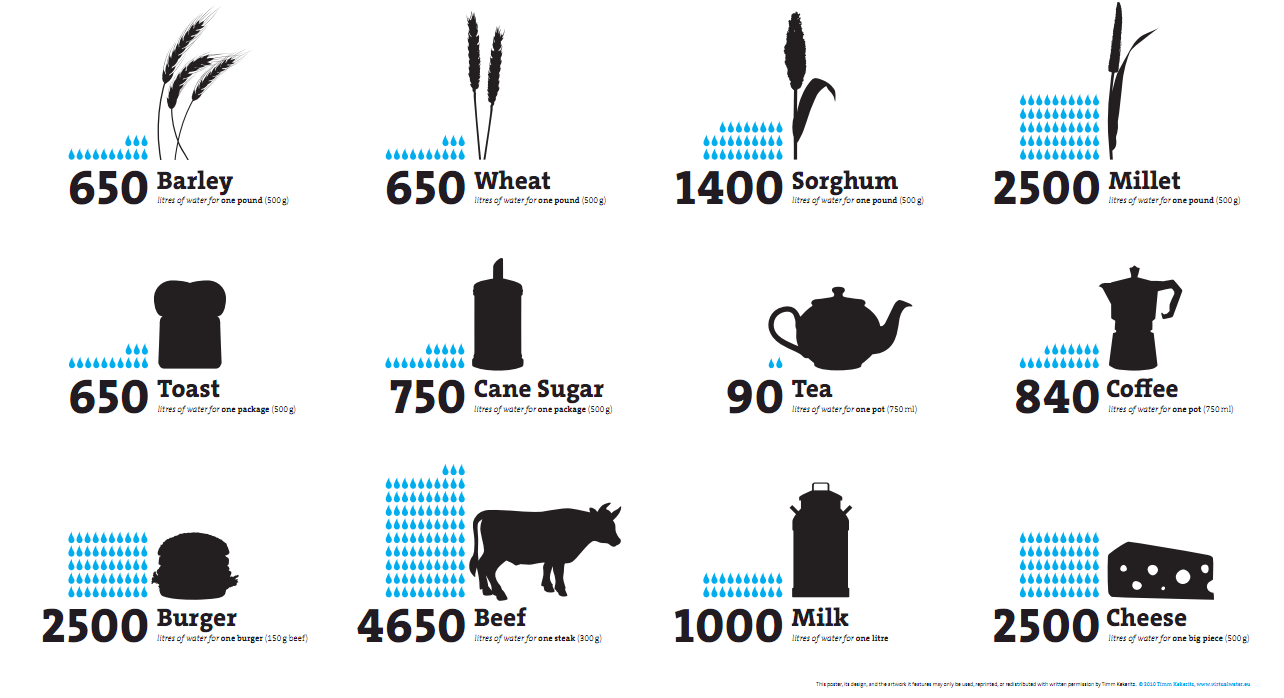Virtual Water: An Introduction
Virtual
Water: An Introduction
This week,
leaving ground water behind and coming out of the earth, I want to focus on a
concept that captures the hidden water integrated into our lives, not
necessarily in forms we might expect. This is the concept of virtual water. For
a more succinct definition: Virtual water is the amount of water required to
produce a product, from start to finish and is a mainly neglected and hidden
component of production (Lillywhite,
2010).
The concept
was first developed as a way of understanding how the volume of water embedded
into food and trade of clothing is vastly greater than the volume of water we
drink. Virtual water creates the idea of a water footprint, similar to that of
an ecological footprint, making the consumer focus on the production chain as
well as the final product (VirtualWater, 2019).
To put the
concept into perspective; the average person drinks around 900
to 1000 litres of water per year, the simple average of between 2 to 3 litres a
day. Comparatively, just 500g of barley requires 650 litres of water to grow. This
means that to grow less than a kilogram of barley you would have to use an
entire year worth of water to drink (Yang, 2007).
Even worse than crops, 500g of beef requires over 8,000 litres of water to
produce, enough water for 8 people to comfortably live for a year.
Source: (VirtualWater, 2019)
The image is an infographic showing
the varying levels of water required to produce certain commodities.
The
concept, created by professors in Kings College London and The School of Oriental and African Studies, opens our eyes to the scale of water integrated
or embedded into our lives that we do not consider. The concept helps people
understand how much water goes into the production and trade of food and other
consumer products like cotton (Allan,
2005).
The concept
of virtual water can be used in the context of trade as when services or goods are
exchanged, virtual water is exchanged and traded too. The concept is useful
when looking into arid or semi-arid environments and their consumption. A
country importing a tonne of wheat saves about 1,300 cubic metres of water
compared to producing it domestically. If the country in question is water
scarce, like the majority of the countries in Sub-Saharan Africa, the water
saved can be put towards other means (Fekete,
2013). However, if the exporting country is water-scare, it has lost that
volume of water, meaning it will no longer be available for other purposes.
The
creator of the concept, Professor John Anthony Allan, justifies virtual water
below:
“The water
is said to be virtual because once the wheat is grown, the real water used to
grow it is no longer actually contained in the wheat. In semi-arid and arid
areas, knowing the virtual water value of a good or service can be useful
towards determining how best to use the scarce water available.”
When we
apply the idea of virtual water to the water stressed nations of Africa, we
look to analyse the link between it and levels of development. The biggest net importers
of virtual water are North Africa and the Middle East, hardly surprising as
they are also the most water stressed nations. Countries in Africa are starting
to manage imports and exports by the volume of water embedded in the product (Lillywhite,
2010). By importing products that have a high amount of embedded water and
exporting products with low embedded water, the country can effectively reduce
the volume of water it uses at minimal cost.
I hope
this blog has given a clear introduction to the concept of virtual water.

Comments
Post a Comment